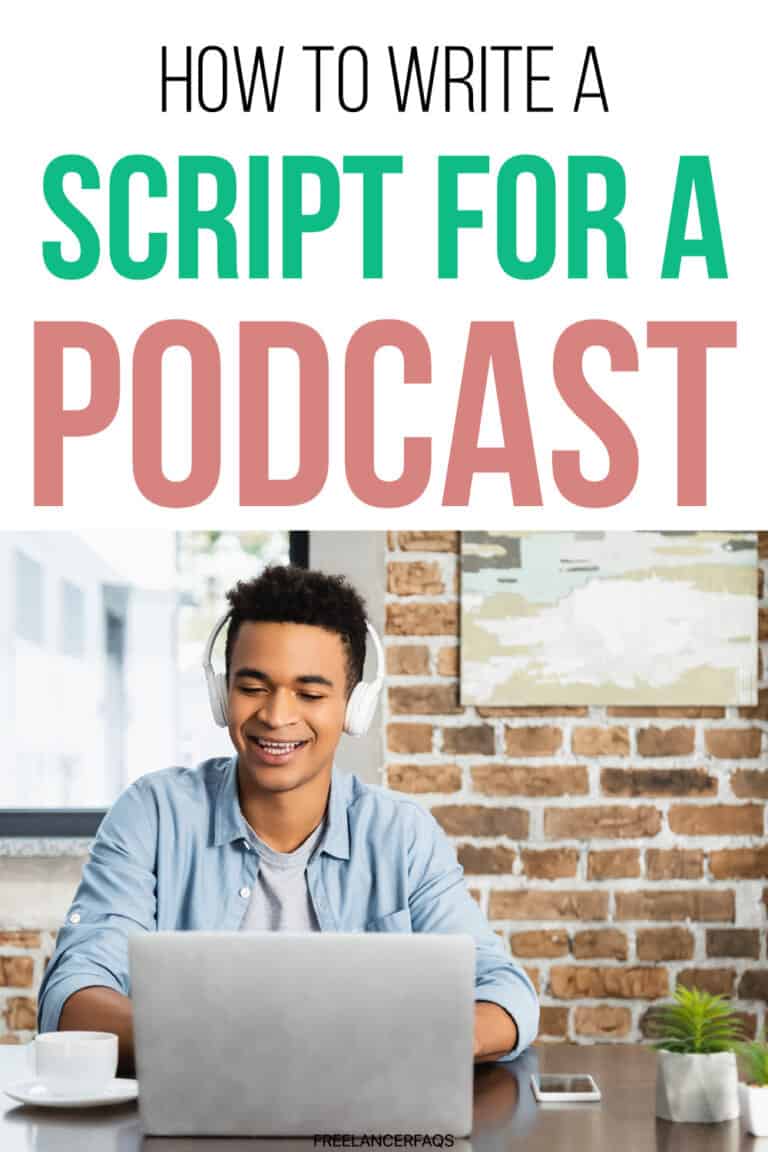How many of you – yes, freelancers – have ever had this experience?
You’re sitting on the couch, relaxing with your spouse or kids.

Suddenly, you hear a podcast episode playing in the background, and it captures your attention.
With every sentence spoken on the show, you find yourself more intrigued by what is being said until finally, you stop what you are doing to listen to the entire thing from start to finish!
[P]odcasts have become so trendy during current times the niche must be as specific as possible.
Freelance podcast script writing is a unique niche, but it recently became more popular with the rise in the popularity of podcasts.
In this blog post, I will be exploring how to write a script for a podcast that sells so that your listeners want nothing but what you’re offering!
Script writing is awesome, fun, and high-paying.
Here are the five stages you should follow to ensure it does:
Pre-Production
Before you begin any paid work, your freelance client should provide you with some general pointers to ensure that both parties are on the same page and avoid unnecessary revisions later.
Ask the essential questions in the pre-production stage.
Freelancers shouldn’t forget that most clients don’t know what information they need to write the podcast script. That’s why we need to know what are the right questions to ask.
These are some things you should ask:
- The podcast niche
- The episode’s content
- Main keywords of the episode
- Average episode length
- Participants, such as interviewees and co-hosts
The niche defines what topics the podcast covers. Since podcasts have become so trendy during current times, the niche must be as specific as possible. A specific niche helps the podcast stand out from the competition.
If the podcast’s niche is psychology, that’s too general.
If it’s clinical psychology, that’s more specific. If it’s cognitive behavioral therapy techniques for clinical psychologists, that’s more specialized and can stand out better—the more hyper-specialized, the lesser competition.
You can assist the client with narrowing their niche down if it seems too general or vague before you engage in writing the script.
A client will likely already provide you with a title for their podcast and have you write it as a literary script, though some clients will have you look for the topic ideas and turn them into episode titles yourself.
1. Outline

Once you have all the essential knowledge, creating an outline draft follows suit.
The outline draft will look like this:
- Introduction
- Intro Music
- Hook
- Presentation
- Content
- Content Introduction
- Main content
- Discussion
- Conclusion
- Summary
- Promotion
- Outro
You can modify the outline depending on your personal preferences and those of your client.
I enjoy this outline because it follows the rule of three, with three different parts of the podcast and each central part subdivided into three acts of their own.
Once the outline is done, you can begin with the production, which is the writing of the script itself.
Let’s go through each of the acts of the outline:
2. Introduction
The purpose of the introduction is to throw the audience into action by hooking them and preluding the most exciting content by teasing what’s coming next.
The introduction is the most crucial part of the podcast, and it can make or break a successful episode.
Intro Music (0:00 – 0:30)
Many podcasts begin their introduction section with an intro tune, which is the hook before the hook.
The intro music is the most recurring opening of a podcast.
Every episode’s hook will be different, but the intro music will always be the same. The intro music increases consistency like a YouTube channel introduction does.
Consistency makes your branding easier to grasp.
The intro music subconsciously introduces the audience into a specific mood that can make it easier to connect with the podcast’s theme.
The Mythcreants podcast, for example, includes a catchy song for its intro tune.
The song fits within the fantasy, sci-fi, and trope analysis theme the podcast presents and sets the mood for what’s coming.
The Speaking of Psychology podcast includes a wordless tune that sets the mood for the podcast. It’s formal and soothing, allowing listeners to ease themselves into the mood of the podcast.
Hook (0:31 – 0:45)
Think of what’s the best content you’ll be presenting in the podcast.
If the podcast is about a trending topic, mention that in the hook. Anything that can keep the audience listening can be added to the hook.
Some podcasts initially hook the audience by inserting a future, juicy part of the script, such as a hilarious joke, a shocking quote, or a revelation from the interviewee.
On the other hand, you can also hook simply by introducing the most important topic of the podcast right away.
Some podcasts also start by asking the viewer a question that would lead to the problem you’re trying to solve.
The podcast hook should let the viewers know why they should stay until the end of the episode.
Presentation (0:45 – 1:20)
The final act of the podcast introduction is the presentation, where you introduce the show hosts, the interviewees, and the podcast’s main topic.
Explain how the content will be developed.
 Some podcasts kickstart the presentation and the content by starting a conversation about the topic right away.
Some podcasts kickstart the presentation and the content by starting a conversation about the topic right away.
End the presentation with a call to action to set the stage for the content.
3. The Content
The content is the second act of each podcast and the longest part of the episode.
It’s the part of the podcast people want to reach as fast as possible, so the introduction should be short and to the point.
Content introduction (1:21 – 5:00)
The content is composed of the primary idea of the episode.
Let’s imagine the podcast episode was titled, “How Depression Affects Teenagers in the Caribbean.”
You can expect the content to include statistics on depression and differences in how it affects teenagers in the Caribbean compared to teenagers from other countries. It’ll also have resources and contacts to reach out to when seeking help.
The main content (5:01 – 30:00)
You teased the main content in the hook, and you’re delivering it straight to your audience’s ears at this stage.
The main content is where the interviewer asks critical questions.
Ask the clinician to share an anecdote about a case of depression he treated or a shocking statistic about the topic.
The main content isn’t engaging just because it’s interesting: it’s compelling because you teased it as important back in the introduction.
You placed the audience in an eager mood and satisfied this hunger for knowledge with the main dish of information.
I always ask my clients for personal stories or anecdotes they’d like to share in this part. If they can contact the guest in advance and forward the questions I come up with, the actual recording is much easier.
Discussion (30:01 – 45:00)
The discussion is the open debate section of the podcast, where you synthesize all the relevant facts to set the stage for the conclusion.
The discussion can help drive the highlights of the main content home by including emotional reactions to what was exposed.
Adding anecdotes that contrast these points can help the hosts connect with their audience, though beware of the pitfalls of personal stories.
A significant podcast pet peeve for most audiences is the hosts going on tangents with the content and discussion, either by veering off-topic or presenting personal stories that have little to do with the main content.
Try to follow the script’s outline and the podcast show notes to avoid the dreaded discussional tangents.
4. Conclusion

The conclusion is the final act of the podcast, where the host, co-host, and interviewee(s) wrap up the discussion and summarize what has been exposed.
Summary (45:01 – 48:00)
A smooth transition from the content to the conclusion is the summary, where you highlight the main takeaways of the content and discussion, in short, precise sentences the audience can take home.
Promotion (48:01 – 49:30)
The podcast has already been wrapped up by the time the summary is over. Hence, the purpose of the promotion is to build a sense of community out of the episode and reinforce the participants’ digital presence.
I use this space to mention my client’s social media handles and that of the guests. The promotion section helps continue the conversation on Twitter or Instagram and opens up the possibilities of Q & A’s.
More commercial podcasts will use this space to promote products, ads, and a final CTA before breaking off.
Outro (49:31 – 50:00)
Some podcasts include an outro tune or a pre-recorded outro similar to the intro tune. An outro tune isn’t mandatory for all podcasts but can still reinforce the feeling of consistency.
5. Post-Production
Whew! That’s it for the outline.
After the script is done, it’s time to edit, add the timestamps and come up with the show notes to help your client understand how to read the podcast script.
Time Stamps
Timestamps are the written expressions of time value.
They represent the numerical value of time in each section of the script, so the client has a general idea of how much time each section should take when recording. They allow the hosts to keep track of time and serve as a measure for them to know if they are reading the script too fast or too slow.
Take a look at this article and notice how each section includes a numerical value in parenthesis.
Those are timestamps, representing how much time these sections should take to read if they were placed on a script, on average. It can vary depending on the podcast’s length and topic, so it’s essential to get it right in the pre-production.
Since you’ll be charging most clients depending on how much time each episode lasts, accurately timestamping the script is crucial for both client and freelancer.
However, not all clients will require timestamps and might avoid them altogether.
Usually, 150-200 words are a minute, so you can calculate where to place the time stamp by reading the script aloud or having google translate read it for you and time it yourself.
The Bottom Line
Podcast writing might seem complex at first, yet it’s by far the funniest freelance writing niche you’ll find. It feels both engaging and rewarding.
You’ll always learn something new when researching topics, organizing them, and helping your clients get their point to a broad audience.



Leave a Reply